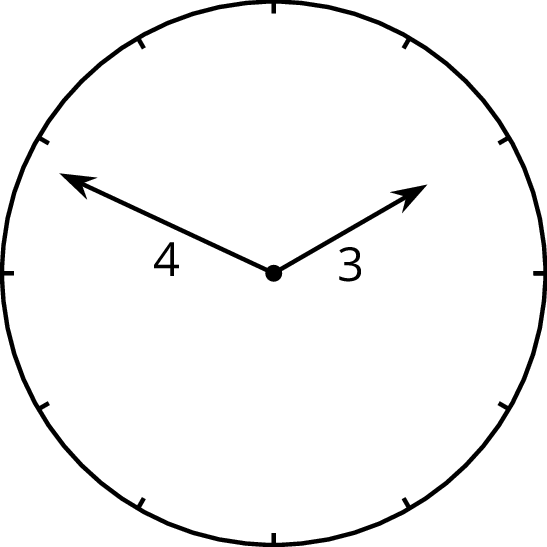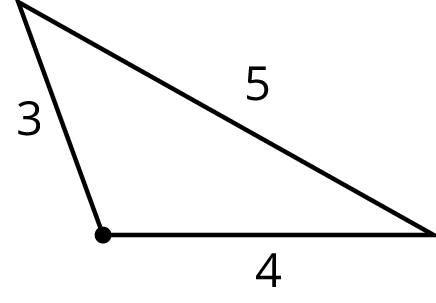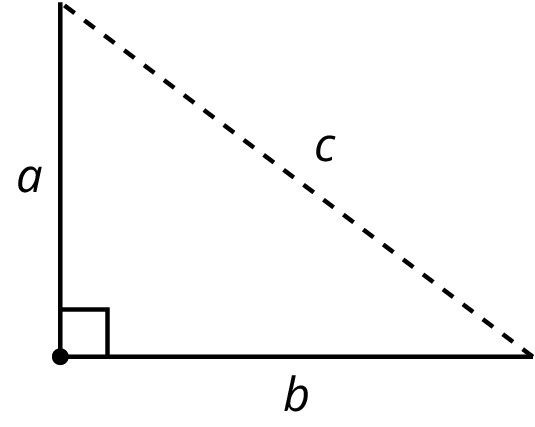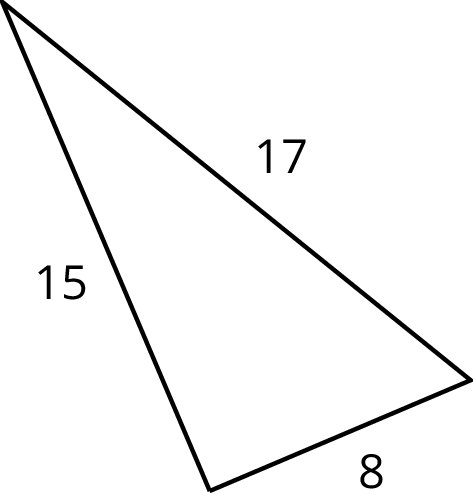Lesson 9
The Converse
9.1: The Hands of a Clock (5 minutes)
Warm-up
This warm-up is preparation for the argument of the converse of the Pythagorean Theorem that we will construct in the next activity. The warm-up relies on the Pythagorean Theorem and geometrically intuitive facts about how close or far apart the two hands of a clock can get from one another.
Launch
Arrange students in groups of 2. Give students 1 minute of quiet think time followed by partner and then whole-class discussions.
Student Facing
Consider the tips of the hands of an analog clock that has an hour hand that is 3 centimeters long and a minute hand that is 4 centimeters long.

Over the course of a day:
-
What is the farthest apart the two tips get?
-
What is the closest the two tips get?
-
Are the two tips ever exactly five centimeters apart?
Student Response
For access, consult one of our IM Certified Partners.
Activity Synthesis
Invite students share their solutions.
Make the following line of reasoning explicit:
Imagine two hands starting together, where one hand stays put and the other hand rotates around the face of the clock. As it rotates, the distance between its tip and the tip of the other hand continually increases until they are pointing in opposite directions. So from one moment to the next, the tips get farther apart.
(Proving this requires mathematics beyond grade 8, so for now we will just accept the results of the thought experiment as true.)
9.2: Proving the Converse (15 minutes)
Activity
This activity introduces students to the converse of the Pythagorean Theorem: In a triangle with side lengths \(a\), \(b\), and \(c\), if we have \(a^2+b^2=c^2\), then the triangle must be a right triangle, and \(c\) must be its hypotenuse. Since up until this unit we rarely phrase things as a formal theorem, this may be the first time students have directly considered the idea that a theorem might work one way but not the other. For example, it is not clear at first glance that there is no such thing as an obtuse triangle with side lengths 3, 4, and 5, as in the image. But since \(3^2+4^2=5^2\), the converse of the Pythagorean Theorem will say that the triangle must be a right triangle.

The argument this activity presents for this result is based on the thought experiment that as you rotate the sides of length 3 and 4 farther apart, the distance between their endpoints also grows, from a distance of 1 when they are pointing in the same direction, to a distance of 7 when pointing in opposite direction. There is then one and only one angle along the way where the distance between them is 5, and by the Pythagorean Theorem, this happens when the angle between them is a right angle. This argument generalizes to an arbitrary right triangle, proving that the one and only angle that gives \(a^2+b^2=c^2\) is precisely the right angle.
The next activity will more heavily play up the distinction between the Pythagorean Theorem and its converse, but it is worth emphasizing here as well.
Launch
Arrange students in groups of 2. Give students 2 minutes of quiet work time. Ask partners to share their work and come to an agreement. Follow with a whole-class discussion.
Supports accessibility for: Conceptual processing
Design Principle(s): Maximize meta-awareness
Student Facing
Here are three triangles with two side lengths measuring 3 and 4 units, and the third side of unknown length.

Sort the following six numbers from smallest to largest. Put an equal sign between any you know to be equal. Be ready to explain your reasoning.
\(\displaystyle 1\qquad 5\qquad 7\qquad x\qquad y\qquad z \)
Student Response
For access, consult one of our IM Certified Partners.
Student Facing
Are you ready for more?
A related argument also lets us distinguish acute from obtuse triangles using only their side lengths.
Decide if triangles with the following side lengths are acute, right, or obtuse. In right or obtuse triangles, identify which side length is opposite the right or obtuse angle.
- \(x=15\), \(y=20\), \(z=8\)
- \(x=8\), \(y=15\), \(z=13\)
-
\(x=17\), \(y=8\), \(z=15\)
Student Response
For access, consult one of our IM Certified Partners.
Activity Synthesis
Select some groups to share the reasoning. It is important to get out the following sequence of ideas:
- Just as we saw with the clock problem, the length of the third side continually increases from 1 to 7 as the angles increases between \(0^\circ\) and \(180^\circ\).
- Because of this, there is one and only one angle along the way that gives a third side length of 5.
- By the Pythagorean Theorem, if the angle is a right angle, the third side length is 5.
Combining these, we see that the one and only angle that gives a third side length of 5 is the right angle. That is, every triangle with side lengths 3, 4, and 5 is a right triangle with hypotenuse 5. Triangles like the one displayed here are thus impossible.

As a class, discuss how the argument could have been run with any two starting side lengths \(a\) and \(b\) instead of specifically \(3\) and \(4\).

Though we do not need to write it as formally, the length of the third side continually increases from \(a-b\) (or \(b-a\)) up to \(a+b\) as the angle increases between \(0^\circ\) and \(180^\circ\). When the angle is a right angle, the third side has length equal to the value of \(c\) that makes \(a^2+b^2=c^2\), and as in the previous discussion, that is the only angle that gives this length.
We conclude that the only way we could have \(a^2+b^2=c^2\) is if the triangle is a right triangle, with hypotenuse \(c\). This result is called the converse of the Pythagorean Theorem. Together, the Pythagorean Theorem and its converse provide an amazing relationship between algebra and geometry: The algebraic statement \(a^2+b^2=c^2\) is completely equivalent to the geometric statement that the triangle with side lengths \(a\), \(b\), and \(c\) is a right triangle.
9.3: Calculating Legs of Right Triangles (10 minutes)
Activity
The purpose of this activity is for students to apply the Pythagorean Theorem and its converse in mathematical contexts. In the first problem, students apply the Pythagorean Theorem to find unknown side lengths. In the second problem, students use the fact that by changing side lengths so that they satisfy \(a^2+b^2=c^2\), the resulting triangle is guaranteed to be a right triangle.
Launch
Provide students with access to calculators.
Student Facing
- Given the information provided for the right triangles shown here, find the unknown leg lengths to the nearest tenth.

- The triangle shown here is not a right triangle. What are two different ways you change one of the values so it would be a right triangle? Sketch these new right triangles, and clearly label the right angle.

Student Response
For access, consult one of our IM Certified Partners.
Activity Synthesis
The goal of this discussion is for students to use the Pythagorean Theorem to reason about the side lengths of right triangles. Select 2–3 students to share their work for the two problems.
For the second problem, make a list of all possible changes students figured out that would make the triangle a right triangle by changing the length of just one side. Depending on where students decided the right angle is located and which side they selected to change, there are nine possible solutions. Can students find them all?
Supports accessibility for: Attention; Social-emotional skills
Design Principles(s): Cultivate conversation; Maximize meta-awareness
Lesson Synthesis
Lesson Synthesis
The purpose of this discussion is to reinforce the takeaways the Pythagorean Theorem and its converse.
- “What has to be true in order to be sure a triangle is a right triangle?” (The sum of the squares of the two shorter sides must equal the square of the longest side.)
Remind students that this is a result of the converse of the Pythagorean Theorem. The Pythagorean Theorem is an example of a theorem where the converse is also true. That is, the Pythagorean Theorem states that for a right triangle with sides \(a\), \(b\), and \(c\), with \(c\) the length of the hypotenuse, the relationship \(a^2+b^2=c^2\) is always true. The converse of the Pythagorean Theorem states that if \(a\), \(b\), and \(c\) are side lengths of a triangle and \(a^2+b^2=c^2\), then the angle opposite the side of length \(c\) is a right angle.
To illustrate this, display the image shown here of a triangle with sides 6, 8, and 10.

Ask students to decide if this is a right triangle or not. After some quiet work time, poll the class for which type of triangle they think it is. Remind students that while the angle across from the side of length 10 looks like a right angle, we can't be sure it is just from the image. However, since \(6^2+8^2=10^2\) is true, We know, by the converse of the Pythagorean Theorem, that the triangle is a right triangle and that the angle across from the side of length 10 is a right angle.
9.4: Cool-down - Is It a Right Triangle? (5 minutes)
Cool-Down
For access, consult one of our IM Certified Partners.
Student Lesson Summary
Student Facing
What if it isn’t clear whether a triangle is a right triangle or not? Here is a triangle:

Is it a right triangle? It’s hard to tell just by looking, and it may be that the sides aren’t drawn to scale.
If we have a triangle with side lengths \(a\), \(b\), and \(c\), with \(c\) being the longest of the three, then the converse of the Pythagorean Theorem tells us that any time we have \(a^2+b^2=c^2\), we must have a right triangle. Since \(8^2+15^2=64+225=289=17^2\), any triangle with side lengths 8, 15, and 17 must be a right triangle.
Together, the Pythagorean Theorem and its converse provide a one-step test for checking to see if a triangle is a right triangle just using its side lengths. If \(a^2+b^2=c^2\), it is a right triangle. If \(a^2+b^2\neq c^2\), it is not a right triangle.